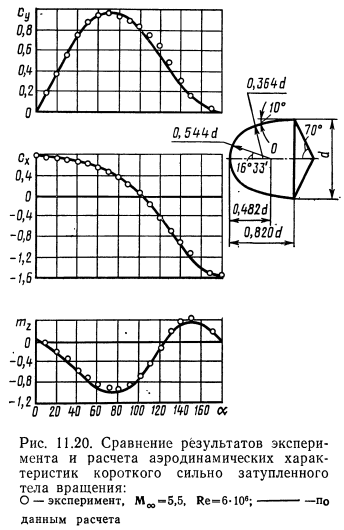Why (then what to feed the ballistic model)
Data is needed to construct trajectories of spacecraft and their carriers. First of all, they are aerodynamic. They are needed to determine the forces and moments acting on the spacecraft (or its stage), as well as to assess the thermal state of the structure. The characteristics depend on the appearance of the spacecraft and flight parameters and usually look like extensive sheets with the dependences of the corresponding coefficients on the angles of attack, Mach numbers, altitudes and much more.
There are several ways to get these numbers:
CFD. Any ANSYS, floEFD, solidWorks flow simulation and so on. Large and serious software packages with a serious price tag. And for a startup that is sawing its shuttle in the garage, this software will cost about the same as the garage itself.
Approximate graphic-analytical methods. Because people have been launching a variety of devices into the air and vacuum for a long time. Data on their flow around in pipes and free flow are entered into directories, tabulated and parameterized by elongations, sweep angles, profile thicknesses, and so on and so forth. The problem with such approaches is the need to work "by eye" with various books and atlases of characteristics, transfer numbers from paper to electronic form and suffer, suffer, suffer when the geometry takes on forms other than the "cylindrical-conical body with a thin wing"
Approximate methods based on local flow parameters. They occupy an intermediate position between the first two and are based on dividing the geometry of the aircraft under study into fragments, the interaction between which can be neglected. Since disturbances in the flow cannot propagate faster than the speed of sound and beyond the shock waves, such methods work best at high speeds (M ~ 8-10 and higher). We will deal with them
The two main methods are the tangent wedge method and the Newton method. In each of the methods, the aircraft surface is divided into elementary areas, then the local angle of attack (between the plane and the incoming flow) is determined. In the method of local jumps, the angle of attack is compared with the maximum allowable one (after it, the jump moves away from the surface), then the degree of pressure increase in the flow is determined.

, , .

- , , . , ( , )
, . - .

( , , ).
. , STL. , , . Blender, , . - STL, Blender- - , (csv, json ). NodeJS Buffer. STL .
fs open , size .
STL

STL. 80 - , . . 4 - 32- Unsigned Int, . - .
32- Float Little Endian. - . (X, Y, Z), . 48 2 16- Unsigned Int, . .
1.
. -, . -, , ( , , )

. 5-10% :


2.
- "". DSMC Simulations of Apollo Capsule Aerodynamics... ( ) .
""


85 ( ) . , ~5%. , AIAA - .
3.
- , . (M ~2 - 3) . ( ).
M = 2 - 6 ( )

- 2, - 4, - 6. -
, M > 3,5 - 4 ~ 90 . M=4, " " .

- ( ). , , . - .

In the meantime, I have a tool that allows me to evaluate the characteristics of a wide variety of pepelats, and in the most interesting corridor of heights and speeds from the point of view of atmospheric flight of spacecraft - with a fairly good (~ 5%) accuracy.
If anyone is interested, the code lives here . Suddenly you will be overtaken by a creative impulse, and you will help me overcome subsonic, transsound and small supersonic.